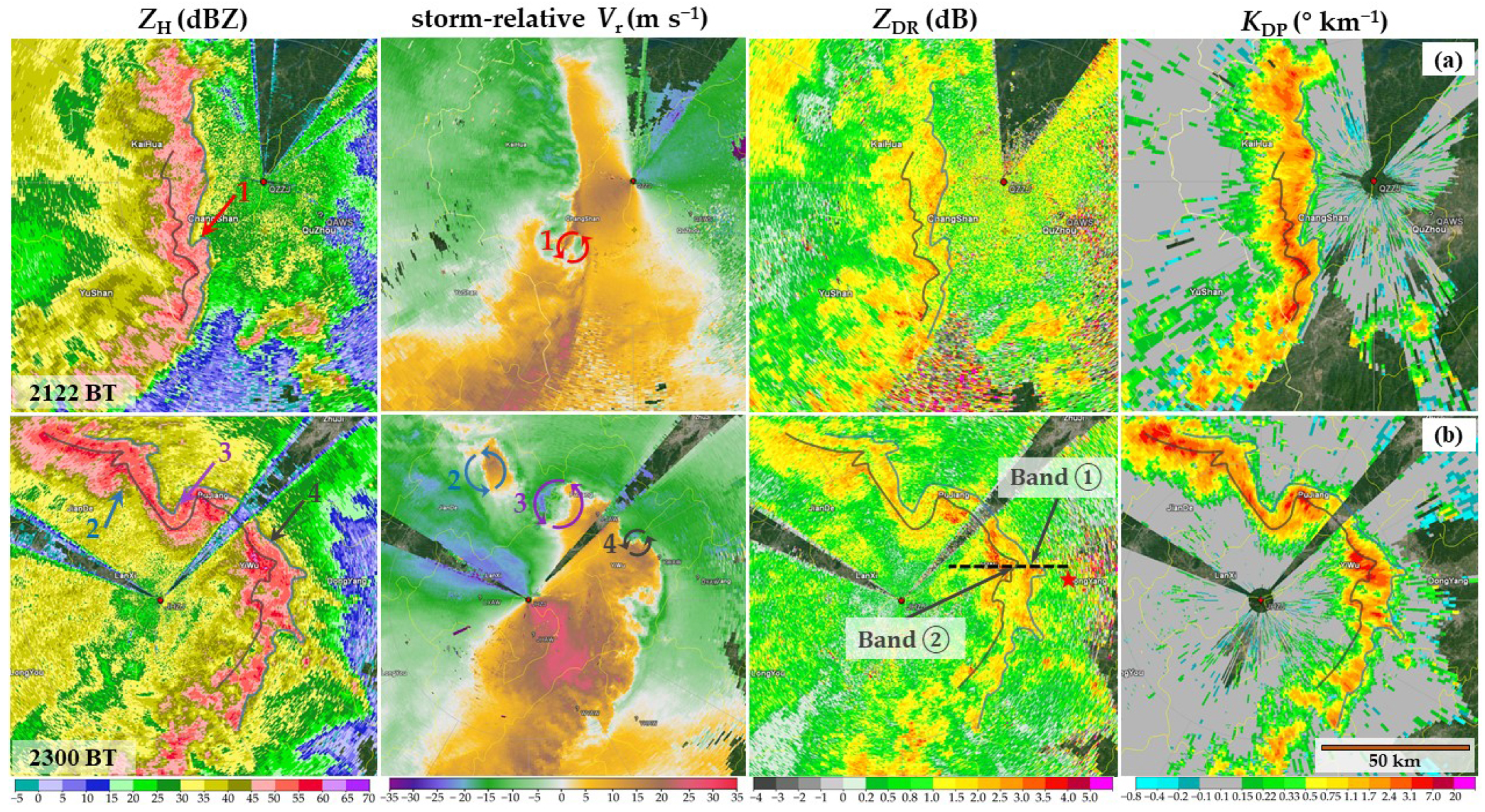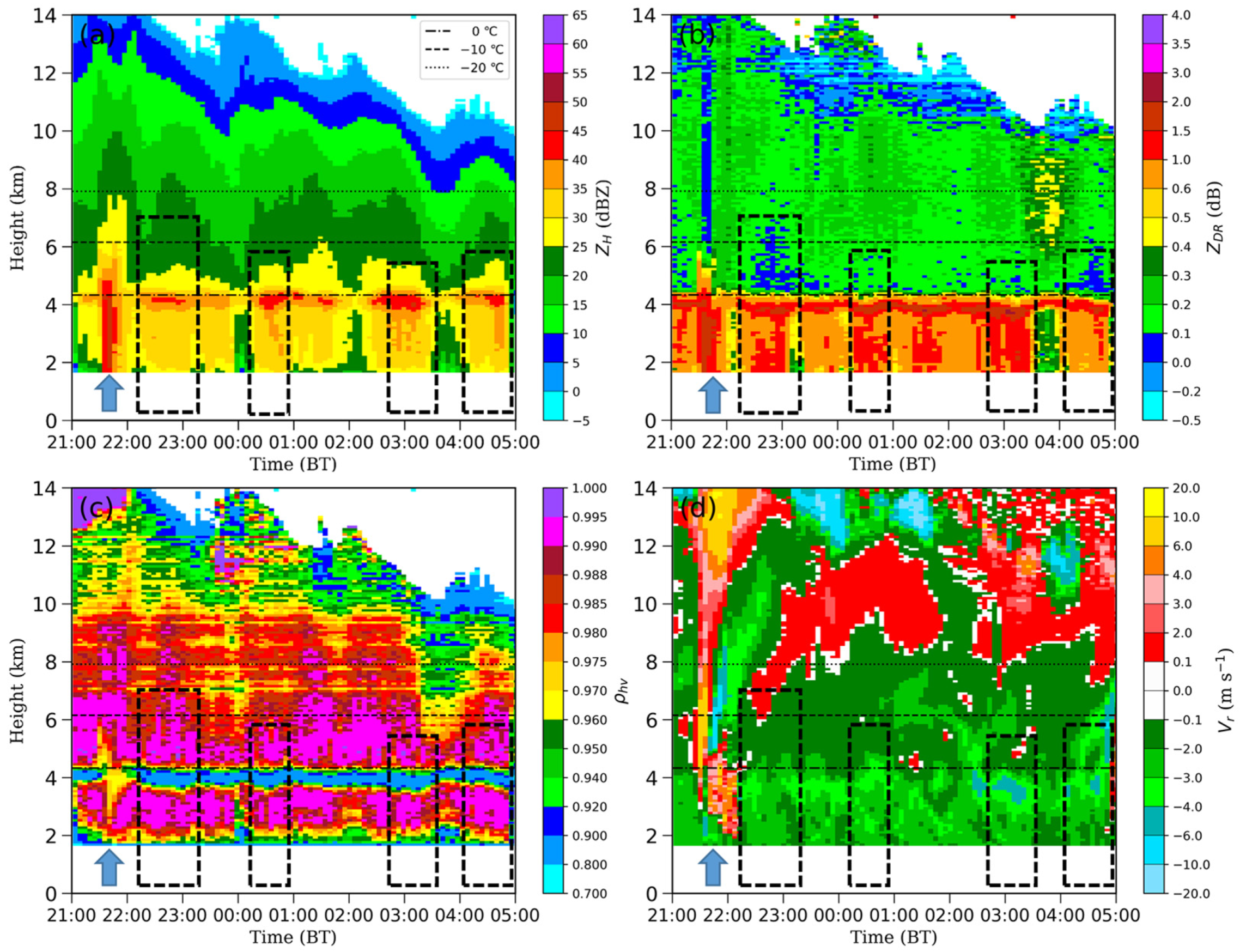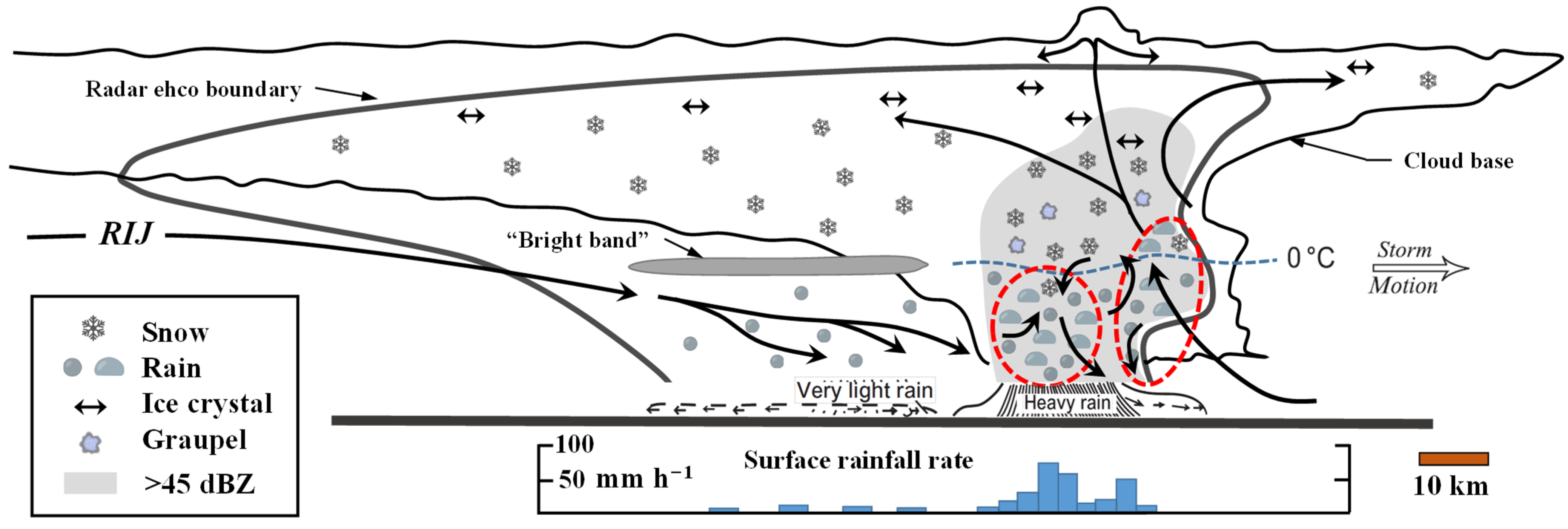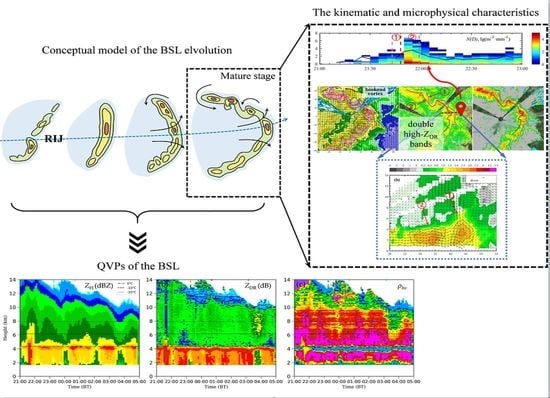Analysis of the Characteristics and Evolution Mechanisms of a Bow-Shaped Squall Line in East China Observed with Dual-Polarization Doppler Radars
Abstract
:1. Introduction
2. Data, Methodology, and Study Area
3. Synoptic and Mesoscale Environment
3.1. Case Description and Synoptic Conditions
3.2. Analysis of Sounding Data
4. Echo Characteristics and Mechanism of Structural Evolution of the BSL
4.1. Echo Structure and Path of the BSL
4.2. Echo Pattern and Mechanism of Evolution of the BSL
5. Dual-Polarization Characteristics and Evolution
5.1. Dual-Polarization Signatures and the Double High-ZDR Bands Feature
5.2. Evolutionary Characteristics of the QVPs of Dual-Polarization Signatures
6. Conclusions
- The presence of an ultralow-temperature region in the middle and upper levels and the transport of warm and humid airflow from the lower level led to the formation of an unstable stratification structure that was cold in the upper region and warm in the lower region. The updraft induced by upper-level divergence, together with thermal instability, promoted the occurrence and development of convection. Moreover, the strong wind shear at 0–6 km facilitated the organization and intensification of the squall-line system.
- The vertical vorticity near the leading edge of the squall line during the mature stage was a good indicator of the organized structure and evolutionary trend of the echo associated with the squall line. In other words, a positive vertical vorticity facilitated the strengthening of the echo and the organization of the echo structure, while a negative vertical vorticity indicated the loosening and weakening of the echo structure.
- The mechanism behind a new echo phenomenon—double high-ZDR bands—observed in dual-polarization radar PPI scans was studied from kinematic and microphysical structural perspectives based on 3D wind fields retrieved from multiradar data in conjunction with dual-polarization signatures and disdrometer observations. ZDR column 1 was caused by the uplifting of large, highly concentrated raindrops or supercooled water droplets over the 0 °C isotherm by the strong updraft at the leading edge of the squall line. Below the 0 °C isotherm, there were large raindrops with a low concentration. ZDR column 2 was induced by the strong downdraft and heavy precipitation behind the squall line, corresponding to a very high surface precipitation intensity. Additionally, both columns were located within the bulk of the squall line.
- The evolutionary characteristics of the microphysical structure of the bulk of the squall line and the saggy bright bands of the stratiform clouds trailing behind it were analyzed based on the QVPs retrieved from QZ-SPOL data. On this basis, together with the above findings, a conceptual model describing this type of BSL in the warm sector was established.
Author Contributions
Funding
Data Availability Statement
Conflicts of Interest
Appendix A
References
- Glickman, T.S. Glossary of Meteorology, 2nd ed.; American Meteorological Society: Boston, MA, USA, 2000; p. 855. [Google Scholar]
- Meng, Z.Y.; Yan, D.C.; Zhang, Y.J. General Features of Squall Lines in East China. Mon. Weather Rev. 2013, 141, 1629–1647. [Google Scholar] [CrossRef]
- Nolen, R.H. A Radar Pattern Associated with Tornadoes. Bull. Am. Meteorol. Soc. 1959, 40, 277–279. [Google Scholar] [CrossRef] [Green Version]
- Atkins, N.T.; Justin, M.A.; Przybylinski, R.W.; Wolf, R.A.; Ketcham, B.D. Vortex Structure and Evolution within Bow Echoes. Part I: Single-Doppler and Damage Analysis of the 29 June 1998 Derecho. Mon. Weather Rev. 2004, 132, 2224–2242. [Google Scholar] [CrossRef] [Green Version]
- Fujita, T.T. Manual of Downburst Identification for Project Nimrod; Satellite and Mesometeorology Research Paper 156; Department of Geophysical Sciences, University of Chicago: Chicago, IL, USA, 1978; p. 104. [Google Scholar]
- Fujita, T.T.; Byers, H.R. Spearhead Echo and Downburst in the Crash of an Airliner. Mon. Weather Rev. 1977, 105, 129–146. [Google Scholar] [CrossRef] [Green Version]
- Weisman, M.L. The Genesis of Severe, Long-Lived Bow Echoes. J. Atmos. Sci. 1993, 50, 645–670. [Google Scholar] [CrossRef]
- Wakimoto, R.M.; Murphey, H.V.; Nester, A.; Jorgensen, D.P.; Atkins, N.T. High Winds Generated by Bow Echoes. Part I: Overview of the Omaha Bow Echo 5 July 2003 Storm during Bamex. Mon. Weather Rev. 2006, 134, 2793–2812. [Google Scholar] [CrossRef] [Green Version]
- Burgess, D.W.; Smull, B.F. Doppler Radar Observations of a Bow Echo Associated with a Long-Track Severe Windstorm. In Proceedings of the 16th Conference on Severe Local Storms, American Meteor Society, Kananaskis, AB, Canada, 22–26 October 1990. [Google Scholar]
- Jorgensen, D.P.; Smull, B.F. Mesovortex Circulations Seen by Airborne Doppler Radar within a Bow-Echo Mesoscale Convective System. Bull. Am. Meteorol. Soc. 1993, 74, 2146–2158. [Google Scholar] [CrossRef] [Green Version]
- Schmidt, J.M.; Cotton, W.R. A High Plains Squall Line Associated with Severe Surface Winds. J. Atmos. Sci. 1989, 46, 281–302. [Google Scholar] [CrossRef] [Green Version]
- Atkins, N.T.; Bouchard, C.S.; Przybylinski, R.W.; Trapp, R.J.; Schmocker, G. Damaging Surface Wind Mechanisms within the 10 June 2003 Saint Louis Bow Echo During Bamex. Mon. Weather Rev. 2005, 133, 2275–2296. [Google Scholar] [CrossRef]
- Davis, C.; Atkins, N.; Bartels, D.; Bosart, L.; Coniglio, M.; Bryan, G.; Cotton, W.; Dowell, D.; Jewett, B.; Johns, R.; et al. The Bow Echo and MCV Experiment: Observations and Opportunities. Bull. Am. Meteorol. Soc. 2004, 85, 1075–1094. [Google Scholar] [CrossRef] [Green Version]
- Klimowski, B.A.; Hjelmfelt, M.R.; Bunkers, M.J. Radar Observations of the Early Evolution of Bow Echoes. Wea. Forecast. 2004, 19, 727–734. [Google Scholar] [CrossRef] [Green Version]
- Wheatley, D.M.; Trapp, R.J.; Atkins, N.T. Radar and Damage Analysis of Severe Bow Echoes Observed During Bamex. Mon. Weather Rev. 2006, 134, 791–806. [Google Scholar] [CrossRef] [Green Version]
- Wakimoto, R.M.; Stauffer, P.; Lee, W. The Vertical Vorticity Structure within a Squall Line Observed During Bamex: Banded Vorticity Features and the Evolution of a Bowing Segment. Mon. Wea. Rev. 2015, 143, 341–362. [Google Scholar] [CrossRef] [Green Version]
- Funk, T.W.; Darmofal, K.E.; Kirkpatrick, J.D.; DeWald, V.L.; Przybylinski, R.W.; Schmocker, G.K.; Lin, Y.J. Storm Reflectivity and Mesocyclone Evolution Associated with the 15 April 1994 Squall Line over Kentucky and Southern Indiana. Wea. Forecast. 1999, 14, 976–993. [Google Scholar] [CrossRef]
- Trapp, R.J.; Weisman, M.L. Low-Level Mesovortices within Squall Lines and Bow Echoes. Part II: Their Genesis and Implications. Mon. Wea. Rev. 2003, 131, 2804–2823. [Google Scholar] [CrossRef] [Green Version]
- Atkins, N.T.; Laurent, M.S. Bow Echo Mesovortices. Part II: Their Genesis. Mon. Weather Rev. 2009, 137, 1514–1532. [Google Scholar] [CrossRef] [Green Version]
- Bringi, V.; Chandrasekar, V. Polarimetric Doppler Weather Radar. Principles and Applications; Cambridge University Press: Cambridge, UK, 2001; pp. 378–531. [Google Scholar]
- Ryzhkov, A.V.; Zrnić, D. Radar Polarimetry for Weather Observations; Springer International Publishing: Cham, Switzerland, 2019; pp. 63–143. Available online: https://link.springer.com/book/10.1007/978-3-030-05093-1 (accessed on 1 January 2020).
- Meischner, P.F.; Bringi, V.N.; Heimann, D.; Höller, H. A Squall Line in Southern Germany: Kinematics and Precipitation Formation as Deduced by Advanced Polarimetric and Doppler Radar Measurements. Mon. Weather Rev. 1991, 119, 678–701. [Google Scholar] [CrossRef] [Green Version]
- Evaristo, R.; Scialom, G.; Viltard, N.; Lemaître, Y. Polarimetric Signatures and Hydrometeor Classification of West African Squall Lines. Q. J. R. Meteorol. Soc. 2010, 136, 272–288. [Google Scholar] [CrossRef]
- Wen, J.; Zhao, K.; Huang, H.; Zhou, B.W.; Yang, Z.L.; Chen, G.; Wang, M.J.; Wen, L.; Dai, H.N.; Xu, L.L.; et al. Evolution of Microphysical Structure of a Subtropical Squall Line Observed by a Polarimetric Radar and a Disdrometer During Opacc in Eastern China. J. Geophys. Res. Atmos. 2017, 122, 8033–8050. [Google Scholar] [CrossRef]
- Zhou, A.; Zhao, K.; Lee, W.C.; Huang, H.; Hu, D.M.; Fu, P.L. VDRAS and Polarimetric Radar Investigation of a Bow Echo Formation after a Squall Line Merged with a Preline Convective Cell. J. Geophys. Res. Atmos. 2020, 125, e2019JD031719. [Google Scholar] [CrossRef]
- Xu, A.H.; SUN, J.S.; Xu, D.B.; Wan, X.L.; Guo, Y. Basic Synoptic Situation Classification and Element Character of Severe Convection in China. Meteor Mon. 2014, 40, 400–411. [Google Scholar] [CrossRef]
- Kumjian, M.R.; Khain, A.P.; Benmoshe, N.; Ilotoviz, E.; Ryzhkov, A.V.; Phillips, V.T. The Anatomy and Physics of Zdr Columns: Investigating a Polarimetric Radar Signature with a Spectral Bin Microphysical Model. J. Appl. Meteorol. Climatol. 2014, 53, 1820–1843. [Google Scholar] [CrossRef]
- Wu, B.; Wei, M.; Li, Y. Dual-Polarization Radar Observations of the Evolution of a Supercell Tornado and Analysis of the Echo Mechanisms. Atmosphere 2022, 13, 797. [Google Scholar] [CrossRef]
- Bringi, V.N.; Seliga, T.A.; Cooper, W.A. Analysis of aircraft hydrometeor spectra and differential reflectivity (ZDR) radar measurements during the Cooperative Convective Precipitation Experiment. Radio Sci. 1984, 19, 157–167. [Google Scholar] [CrossRef]
- Zhang, G.; Sun, J.; Brandes, E.A. Improving Parameterization of Rain Microphysics with Disdrometer and Radar Observations. J. Atmos. Sci. 2006, 63, 1273–1290. [Google Scholar] [CrossRef] [Green Version]
- Schuur, T.; Ryzhkov, A.; Heinselman, P.; Zrnic, D.; Burgess, D.; Scharfenberg, K. Observations and Classification of Echoes with the Polarimetric WSR-88D Radar; Report of the National Severe Storms Laboratory; National Severe Storms Laboratory: Norman, OK, USA, 2003; Volume 46, p. 73069. [Google Scholar]
- Zhang, J.; Wang, S.X. An Automated 2D Multipass Doppler Radar Velocity Dealiasing Scheme. J. Atmos. Ocean. Technol. 2006, 23, 1239–1248. [Google Scholar] [CrossRef]
- Shapiro, A.; Potvin, C.K.; Gao, J.D. Use of a Vertical Vorticity Equation in Variational Dual-Doppler Wind Analysis. J. Atmos. Ocean. Technol. 2009, 26, 2089–2106. [Google Scholar] [CrossRef]
- Potvin, C.K.; Shapiro, A.; Xue, M. Impact of a Vertical Vorticity Constraint in Variational Dual-Doppler Wind Analysis: Tests with Real and Simulated Supercell Data. J. Atmos. Ocean. Technol. 2012, 29, 32–49. [Google Scholar] [CrossRef]
- Bousquet, O.; Tabary, P.; Parent du Châtelet, J. Operational multiple-Doppler wind retrieval inferred from long-range radial velocity measurements. J. Appl. Meteorol. Climatol. 2008, 47, 2929–2945. [Google Scholar] [CrossRef]
- Liou, Y.-C.; Chang, Y.-J. A Variational Multiple-Doppler Radar Three-Dimensional Wind Synthesis Method and its Impacts on Thermodynamic Retrieval. Mon. Weather Rev. 2009, 137, 3992–4010. [Google Scholar] [CrossRef]
- de Moraes Frasson, R.P.; da Cunha, L.K.; Krajewski, W.F. Assessment of the Thies optical disdrometer performance. Atmos. Res. 2011, 101, 237–255. [Google Scholar] [CrossRef]
- Sarkar, T.; Das, S.; Maitra, A. Assessment of different raindrop size measuring techniques: Inter-comparison of Doppler radar, impact and optical disdrometer. Atmos. Res. 2015, 160, 15–27. [Google Scholar] [CrossRef]
- Chen, B.J.; Wang, J.; Gong, D.L. Raindrop Size Distribution in a Midlatitude Continental Squall Line Measured by Thies Optical Disdrometers over East China. J. Appl. Meteorol. Climatol. 2016, 55, 621–634. [Google Scholar] [CrossRef]
- Atlas, D.; Srivastava, R.C.; Sekhon, R.S. Doppler Radar Characteristics of Precipitation at Vertical Incidence. Rev. Geophys. 1973, 11, 1–35. [Google Scholar] [CrossRef]
- Friedrich, K.; Higgins, S.; Masters, F.J.; Lopez, C.R. Articulating and Stationary PARSIVEL Disdrometer Measurements in Conditions with Strong Winds and Heavy Rainfall. J. Atmos. Ocean. Technol. 2013, 30, 2063–2080. [Google Scholar] [CrossRef]
- Tokay, A.; Bashor, P.G. An experimental study of smallscale variability of raindrop size distribution. J. Appl. Meteorol. Climatol. 2010, 49, 2348–2365. [Google Scholar] [CrossRef]
- Guyot, A.; Pudashine, J.; Protat, A.; Uijlenhoet, R.; Pauwels, V.; Seed, A.; Walker, J.P. Effect of disdrometer type on rain drop size distribution characterisation: A new dataset for south-eastern Australia. Hydrol. Earth Syst. Sci. 2019, 23, 4737–4761. [Google Scholar] [CrossRef] [Green Version]
- Zhang, G.F. Weather Radar Polarimetry; CRC Press: Boca Raton, FL, USA, 2016; pp. 10–16. [Google Scholar]
- Ryzhkov, A.; Zhang, P.; Reeves, H.; Kumjian, M.; Tschallener, T.; Troemel, S.; Simmer, C. Quasi-vertical profiles–a new way to look at polarimetric radar data. J. Atmos. Ocean. Technol. 2016, 33, 551–562. [Google Scholar] [CrossRef]
- OuYang, S.C.; McNeil, D.; Lin, Y. Entering Irregularity; Meteorological Press: Beijing, China, 2002; pp. 219–221. [Google Scholar]
- Yu, X.D.; Zheng, Y.G. Advances in Severe Convection Research and Operation in China. J. Meteorol. Res. 2020, 34, 189–217. [Google Scholar] [CrossRef]
- Leary, C.A.; Houze, R.A. The Structure and Evolution of Convection in a Tropical Cloud Cluster. J. Atmos. Sci. 1979, 36, 437–457. [Google Scholar] [CrossRef] [Green Version]
- Przybylinski, R.W. The Bow Echo: Observations, Numerical Simulations, and Severe Weather Detection Methods. Wea. Forecast. 1995, 10, 203–218. [Google Scholar] [CrossRef]
- Atkins, N.T.; Cunningham, J.J. The Influence of Low-Level Stable Layers on Damaging Surface Winds within Bow Echoes. In Proceedings of the 23rd Conference on Severe Local Storms, American Meteor Society, Saint Louis, MO, USA, 7 November 2006. [Google Scholar]
- Illingworth, A.J.; Goddard, J.W.; Cherry, S.M. Polarization Radar Studies of Precipitation Development in Convective Storms. Q. J. R. Meteorol. Soc. 1987, 113, 469–489. [Google Scholar] [CrossRef]
- Hall, M.P.; Goddard, J.W.; Cherry, S.M. Identification of Hydrometeors and Other Targets by Dual-Polarization Radar. Radio Sci. 1984, 19, 132–140. [Google Scholar] [CrossRef]
- Caylor, I.J.; Illingworth, A.J. Radar Observations and Modelling of Warm Rain Initiation. Q. J. R. Meteorol. Soc. 1987, 113, 1171–1191. [Google Scholar] [CrossRef]
- Tuttle, J.D.; Bringi, V.N.; Orville, H.D.; Kopp, F.J. Multiparameter Radar Study of a Microburst: Comparison with Model Results. J. Atmos. Sci. 1989, 46, 601–620. [Google Scholar] [CrossRef] [Green Version]
- Zhu, J.S.; Wei, M.; Gao, S.N.; Hu, H.F.; Ma, L. Study on the Scattering Mechanism of Squall Lines with C-Band Dual Polarization Radar. Part I: Echo Characteristics and Particles Phase Recognition. Front. Earth Sci. 2021. [Google Scholar] [CrossRef]
- Zhu, J.S.; Wei, M.; Gao, S.N.; Lu, C.S. The Scattering Mechanism of Squall Lines with C-Band Dual Polarization Radar. Part II: The Mechanism of an Abnormal ZDR Echo in Clear Air Based on the Parameterization of Turbulence Deformation. Front. Earth Sci. 2021. [Google Scholar] [CrossRef]
- Kumjian, M.R.; Mishra, S.; Giangrande, S.E.; Toto, T.; Ryzhkov, A.V.; Bansemer, A. Polarimetric Radar and Aircraft Observations of Saggy Bright Bands During MC3E. J. Geophys. Res. Atmos. 2016, 121, 3584–3607. [Google Scholar] [CrossRef] [Green Version]
- Vogel, J.M.; Fabry, F. Contrasting Polarimetric Observations of Stratiform Riming and Nonriming Events. J. Appl. Meteorol. Climatol. 2018, 57, 457–476. [Google Scholar] [CrossRef]
- Zawadzki, I.; Szyrmer, W.; Bell, C.; Fabry, F. Modeling of the Melting Layer. Part III: The Density Effect. J. Atmos. Sci. 2005, 62, 3705–3723. [Google Scholar] [CrossRef]
- Griffin, E.M.; Schuur, T.J.; Ryzhkov, A.V. A Polarimetric Radar Analysis of Ice Microphysical Processes in Melting Layers of Winter Storms Using S-Band Quasi-Vertical Profiles. J. Appl. Meteorol. Climatol. 2020, 59, 751–767. [Google Scholar] [CrossRef]
- Carlin, J.T.; Ryzhkov, A.V. Estimation of Melting-Layer Cooling Rate from Dual-Polarization Radar: Spectral Bin Model Simulations. J. Appl. Meteorol. Climatol. 2019, 58, 1485–1508. [Google Scholar] [CrossRef]
- Li, H.; Tiira, J.; Lerber, A.V.; Moisseev, D. Towards the Connection between Snow Microphysics and Melting Layer: Insights from Multifrequency and Dual-Polarization Radar Observations During BAECC. Atmos. Chem. Phys. 2020, 20, 9547–9562. [Google Scholar] [CrossRef]
- Shapiro, A.; Ellis, S.; Shaw, J. Single-Doppler Velocity Retrievals with Phoenix II Data: Clear Air and Microburst Wind Retrievals in the Planetary Boundary Layer. J. Atmos. Sci. 1995, 52, 1265–1287. [Google Scholar] [CrossRef] [Green Version]
- Potvin, C.; Betten, D.; Wicker, L.; Elmore, K.; Biggerstaff, M. 3DVAR versus Traditional Dual-Doppler Wind Retrievals of a Simulated Supercell Thunderstorm. Mon. weather Rev. 2012, 140, 3487–3494. [Google Scholar] [CrossRef]
- Peskin, C. Flow Patterns around Heart Valves: A Numerical Method. J. Comput. Phys. 1972, 10, 252–271. [Google Scholar] [CrossRef]
- Liou, Y.C.; Chang, S.F.; Sun, J. An Application of the Immersed Boundary Method for Recovering the Three-Dimensional Wind Fields over Complex Terrain Using Multiple-Doppler Radar Data. Mon. Weather Rev. 2012, 140, 1603–1619. [Google Scholar] [CrossRef] [Green Version]
- Bell, M.; Montgomery, M.; Emanuel, K. Air–Sea Enthalpy and Momentum Exchange at Major Hurricane Wind Speeds Observed During Cblast. J. Atmos. Sci. 2012, 69, 3197–3222. [Google Scholar] [CrossRef]













| HZ-SPOL | QZ-SPOL | JH-SPOL | NB-SPOL | LSRD | |
|---|---|---|---|---|---|
| Wavelength (cm) | 10.9 | 11.0 | 10.9 | 10.8 | 10.4 |
| Peak power (kW) | 700 | 700 | 700 | 700 | 700 |
| PRF (Hz) * | variable from 322 to 1304 | variable from 322 to 1304 | variable from 322 to 1304 | variable from 322 to 1304 | variable from 322 to 1304 |
| Pulse width (μs) | 0.42, 0.83, 1.57, 4.7 | 1.57, 4.7 | 1.57, 4.7 | 1.57, 4.7 | 1.57, 4.7 |
| Antenna gain (dB) | 44.57 | 44.92 | 44.74 | 45.01 | 45.5 |
| Data range resolution (m) | 125 | 250 | 250 | 250 | 1000 |
| Azimuthal resolution (°) | 0.5 | 1.0 | 1.0 | 1.0 | 1.0 |
| Horizontal beamwidth (°) | 0.99 | 0.93 | 0.98 | 0.93 | 0.93 |
| Vertical beamwidth (°) | 0.95 | 0.94 | 0.95 | 0.95 | — |
| Scan properties | 9 elev (0.5°–19.5°) in 4 min | 9 elev (0.5°–19.5°) in 6 min | 9 elev (0.5°–19.5°) in 6 min | 9 elev (0.5°–19.5°) in 6 min | 9 elev (0.5°–19.5°) in 6 min |
Publisher’s Note: MDPI stays neutral with regard to jurisdictional claims in published maps and institutional affiliations. |
© 2022 by the authors. Licensee MDPI, Basel, Switzerland. This article is an open access article distributed under the terms and conditions of the Creative Commons Attribution (CC BY) license (https://creativecommons.org/licenses/by/4.0/).
Share and Cite
Wu, B.; Wei, M.; Li, Y.; Wang, Z.; Du, S.; Zhao, C. Analysis of the Characteristics and Evolution Mechanisms of a Bow-Shaped Squall Line in East China Observed with Dual-Polarization Doppler Radars. Remote Sens. 2022, 14, 3531. https://doi.org/10.3390/rs14153531
Wu B, Wei M, Li Y, Wang Z, Du S, Zhao C. Analysis of the Characteristics and Evolution Mechanisms of a Bow-Shaped Squall Line in East China Observed with Dual-Polarization Doppler Radars. Remote Sensing. 2022; 14(15):3531. https://doi.org/10.3390/rs14153531
Chicago/Turabian StyleWu, Bin, Ming Wei, Yanfang Li, Zhangwei Wang, Shuang Du, and Chen Zhao. 2022. "Analysis of the Characteristics and Evolution Mechanisms of a Bow-Shaped Squall Line in East China Observed with Dual-Polarization Doppler Radars" Remote Sensing 14, no. 15: 3531. https://doi.org/10.3390/rs14153531
APA StyleWu, B., Wei, M., Li, Y., Wang, Z., Du, S., & Zhao, C. (2022). Analysis of the Characteristics and Evolution Mechanisms of a Bow-Shaped Squall Line in East China Observed with Dual-Polarization Doppler Radars. Remote Sensing, 14(15), 3531. https://doi.org/10.3390/rs14153531







